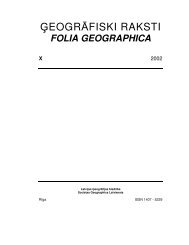eogrÄfiski raksti folia geographica xii - Ä¢eogrÄfijas un Zemes zinÄtņu ...
eogrÄfiski raksti folia geographica xii - Ä¢eogrÄfijas un Zemes zinÄtņu ...
eogrÄfiski raksti folia geographica xii - Ä¢eogrÄfijas un Zemes zinÄtņu ...
Create successful ePaper yourself
Turn your PDF publications into a flip-book with our unique Google optimized e-Paper software.
11<br />
GENERAL TRENDS<br />
co<strong>un</strong>ted. Almost three out of four (73.4%) articles in these journals of human geography came<br />
from the USA and the UK, and the great majority of editorial board members was either British<br />
or American.<br />
Geografiski Raksti / Folia Geographica<br />
The insitutionalization of geography and recent debates on <strong>geographica</strong>l publishing have<br />
an impact also on Latvia. To contextualize the current challenges I take a brief overview of the<br />
development of <strong>geographica</strong>l research in Latvia. Geografiski Raksti / Folia Geographica<br />
(GRFG) was fo<strong>un</strong>ded in 1929 by the Latvian Geographical Society. The aim of the journal was<br />
to publish scientific <strong>geographica</strong>l articles from both physical and human <strong>geographica</strong>l<br />
viewpoints [Krauklis 1999].<br />
Geographical research in Latvia dates back to the 19 th century. Thus it did not emerge<br />
with GRFG or with the establishment of the Institute of Geography in the early 20 th century. It<br />
was nevertheless important that the GRFG contained scientific <strong>geographica</strong>l articles in the<br />
Latvian language. During the first period (1929–1938) six volumes were published. The<br />
la<strong>un</strong>ching of the journal was connected to the emergence of Latvia as an independent state. As<br />
in many other co<strong>un</strong>tries, due to national pride of the people, educational and practical needs of<br />
the state, full academic structures in geography were established, regardless of the quite small<br />
size of Latvia and the number of its scholars. Besides the <strong>un</strong>iversity, <strong>geographica</strong>l research was<br />
conducted also at the Academy of Sciences.<br />
The new state needed systematic <strong>geographica</strong>l knowledge about its territory published in<br />
Latvian. Krauklis (1999) indicates how GRFG helped to fulfill this task with articles such as<br />
“The geographic regions of the territory of Latvia” by Ģederts Ramans in 1935, “The geography<br />
of Latvia’s soils” by Jānis Vītiņš in 1929 and “Latvia’s bogs” by Pēteris Nomals in 1930.<br />
(Ramans 1935, Vītiņš 1929, Nomals 1930) These kinds of comprehensive territorial overviews<br />
were common to many national <strong>geographica</strong>l journals of yo<strong>un</strong>g independent states.<br />
During the Soviet period geography emerged as a more applied structure. It was<br />
integrated into the centrally-planned system for the use of natural and social resources of the<br />
Soviet Union. Geography at the <strong>un</strong>iversity paid more attention to teaching than research, as was<br />
the case before. Most scientific, geographic research was conducted at the Academy of<br />
Sciences. During the Soviet era GRFG was not published. However, the publication concerning<br />
<strong>geographica</strong>l phenomena in Latvia did not cease to exist entirely. Some findings were published<br />
in Latvian in the publication series of the Academy of Science and others by the State<br />
University of Latvia. Some research was published also outside Latvia in the Soviet Union in<br />
the Russian language.<br />
The regaining of independence of Latvia in 1991 placed geography once again on the<br />
agenda in the co<strong>un</strong>try. There was a need to ‘remap’ independent Latvia and its particularities<br />
during the transition period from autocratic to democratic rule. The annual publishing of GRFG<br />
was reinstated from 1999 onwards and the journal took the initiative to emphasize the<br />
contemporary changes in Latvian environment and society. Examples of such topical articles<br />
are: “Reproduction of population in Latvia during transition period” by Pārsla Eglīte in 1999;<br />
“Latvian population mobility in the transition period” by Andris Bauls and Zaiga Krišjāne in<br />
2000; “Seasonal and long-term changes of river discharges in Latvia” in 2001 by Agrita Briede,<br />
Māris Kļavinš, Valerijs Rodinovs & Ilga Kokarīte; “Prospects for regional development in<br />
Latvia: trends and strategies” by Pēteris Šķiņķis in 2001; and “Changes in the city centre of<br />
Riga” by Harald Standl in 2002 [Eglīte 1999; Bauls, Krišjāne 2000; Šķiņķis 2001; Briede et.al.<br />
2001; Standl 2002]. Also more general, broader and interdisciplinary approaches have appeared,<br />
such as “Living with diversity in Latvia: people, nature and cultural landscapes” by Ādolfs<br />
Krauklis in 2000. [Krauklis 2000]<br />
A total of 53 articles by 51 different authors have been published in the GRFG between<br />
1999–2003 (if all published texts are co<strong>un</strong>ted as articles – Table 1). There is a dominance of<br />
human <strong>geographica</strong>l themes over physical <strong>geographica</strong>l ones. With one author alone there have<br />
been published 30 articles and 23 with several authors – the latter most often in physical<br />
geography. The articles have been predominantly in Latvian (33) but there have been also

















